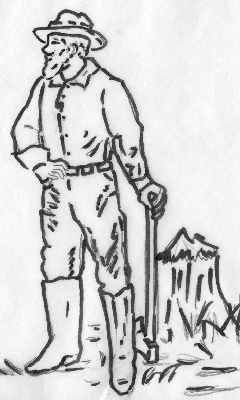Biographical sketch of Orville Sutherland Cox, continued
7 Family Divided, Orderville
Elvira, with Orville a grown son, Walter 17, Tryphena, Amasa and Euphrasia, returned to the old home in Fairview, leaving all of their beautiful peach orchards and vineyards, fields of cotton, cane, wheat and the comfortable houses in the most fertile of lands, which they had subdued and made to “Blossom as the rose” by seven long years of toil and privation. The rendered absolute obedience to their great leader; and so they hitched up their teams, took their most choice belongings, and wended their way back to Utah, leaving their settlement and farms to pay Nevada the back taxes it had demanded.
One company which had thoroughly learned the trick of building a dam in quicksand of the desert, stopped at an abandoned settlement in Long Valley, Kane County. O. S. Cox and sons began the engineering of irrigation canals and dams, and so on, as they had cleaned and repaired the deserted cabins, so that they offered partial shelter from the February storms. The people named this town Mt. Carmel.
 When the former settlers learned that they had built dams that would stand, they came back and said “Get out, this is ours.” So the weary pioneers moved again, this time only a few miles farther up the valley into a pleasant narrow cove, and went to work to build more dams, more ditches and more cabins. In one place the water had to be carried across a gulley, and it gave more trouble than all the rest of the canal. After a while Cox, without comment or any consultation, went into the timber and found a very large log and felled it, made of it a huge trough, placed it across the gully and it reached far enough to secure a solid bed above the quicksand. Thirty years later, this “Cox Trough” was still doing successful service as a flume.
When the former settlers learned that they had built dams that would stand, they came back and said “Get out, this is ours.” So the weary pioneers moved again, this time only a few miles farther up the valley into a pleasant narrow cove, and went to work to build more dams, more ditches and more cabins. In one place the water had to be carried across a gulley, and it gave more trouble than all the rest of the canal. After a while Cox, without comment or any consultation, went into the timber and found a very large log and felled it, made of it a huge trough, placed it across the gully and it reached far enough to secure a solid bed above the quicksand. Thirty years later, this “Cox Trough” was still doing successful service as a flume.

Then dissatisfaction and disunion came, and the “Order” broke up. There was not a great deal of property to divide, although some people came out with more property than others, according to the amount they consecrated in. Mary and Eliza, father’s second and third wives, each received a team and wagon. Mary and her family located in Huntington, Emery County; Eliza and her family in Tropic, Garfield County. Father was then well along in years, and broken in health. He could do little more than advise his sons. Eliza was dying of cancer. In 1886 Orville S. Cox came to Fairview to the best-provided for branch of his family. One year he remained an invalid, and on July 4, 1888 he laid his exhausted body down to rest. His two wives, Elvira and Mary, and many of his descendents were with him at the last.
The following are some of the thriving towns O. S. Cox assisted in founding: Lima, Ill.; Pisgah, Iowa; Salt Lake City, Bountiful, Manti, Gunnison, Fairview, Glenwood of Utah; St. Thomas, St. Joseph, Overton of Nevada; Mt. Carmel, Orderville and Tropic of Utah.
If ever a man earned his salvation, surely O. S. Cox did. Always found in the van where the hardest work was to be done, and if he advanced the cause one iota, no matter at what loss or cost to himself, he considered he had been eminently successful. Never was there a murmur from him.